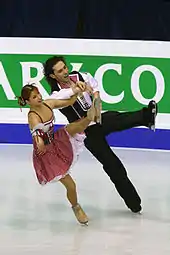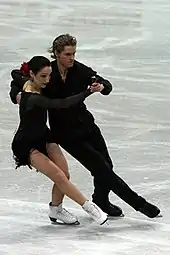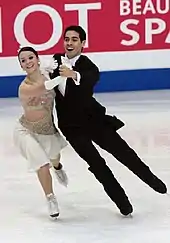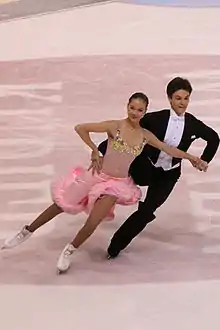Compulsory dance
The compulsory dance (CD), now called the pattern dance, is a part of the figure skating segment of ice dance competitions in which all the couples or solo dancers perform the same standardized steps and holds to music of a specified tempo and genre. One or more compulsory dances were usually skated as the first phase of ice dancing competitions. The 2009–10 season was the final season in which the segment was included in International Skating Union (ISU) junior and senior level competition. In June 2010, the ISU replaced the name "compulsory dance" with "pattern dance" for ice dance, and merged it into the short dance (SD) beginning in the 2010–11 figure skating season.
.jpg.webp)
The first CDs were developed during the 1930s by teams from Great Britain, who dominated ice dance for most of the early years after the sport was contested at the 1952 World Championships. The prominence of the CD in ice dance slowly declined, until it was removed and replaced by the SD in 2011, the year that the ISU voted to restructure ice dance competitions by removing the compulsory dance and original dance (OD) and replacing them with the short dance and free dance (FD).
Ice dancers performed the same pattern around the rink once or twice, to the same step sequences and the same standardized tempo. The competitors were then scored based on their execution of the various elements of the dance. The CD allowed the judges to compare the technical skills of each dancer.
Background
.jpg.webp)
Ice dance was contested for the first time at the World Championships in 1952; for most of that period, the British dominated the sport, winning 12 out of the next 16 championships. Many of the first CDs were developed during the 1930s by teams from Great Britain, some of which have been used by ice dance teams throughout the history of the sport.[1] The CD's prominence in ice dance slowly declined. In 1952, CDs accounted for 60% of the total points dancers could earn. When the Original dance (OD) was added in 1967, it replaced the second CD.[2] In 1988, the same year compulsory figures was removed from women's and men's single figure skating, CDs were decreased from three to two.[3]
In 2010, after urging from the International Olympic Committee (IOC) to decrease the number of segments from three to two "for some time",[4] the ISU voted to remove the CD from competitions, replacing it with the SD.[5][6] According to then-ISU president Ottavio Cinquanta, the change was also made because "the compulsory dances were not very attractive for spectators and television".[6] The SD had to incorporate a compulsory element in which each dance team must perform the same two patterns of a set pattern dance. Its rhythms and themes are determined beforehand by the ISU.[7][8][note 1] The ice dancers are judged on how well they integrate the pattern dance into the entire SD.[10]
The 2010 World Championships was the last event to include a CD (the Golden Waltz), with Federica Faiella and Massimo Scali from Italy being the last dance team to perform a CD in competition.[4]
The CD reflected the emphasis of early figure skating on competitors all skating to the same dance, with the same criteria. This included the dancers' skating skills, their interpretation of the dance and music, their timing, and their performance. The CD has been compared with compulsory figures in singles skating; ice dancers performed the same pattern around the rink once or twice, to the same step sequences and the same standardized tempo, chosen by the ISU before the beginning of each season.[2][11][12] The ISU also published descriptions and diagrams of the chosen dances, and competitors had to follow its dance positions, steps, movement, and timing.[13] They were expected to cover the entire surface of the ice rink, without "an apparent struggle for speed",[13] because it required the use of good flow and deep edges in skating. Dancers were not allowed to cross the center link of rinks in a regulation-sized arena (100 x 200 feet).[13] Competitors were "judged for their mastery of fundamental elements" [11] and CDs "provided an essential comparison of the dancers' technical skills".[7] There was some latitude given to competitors that allowed them to "demonstrate their own personal style",[13] usually done with using a variety of leg and/or arm movements. Despite having to follow the same set pattern, each performance needed to have "a distinct flavor", with different interpretations of the dance based upon the patterns in the music.[13]
Dances




The dances that have been performed in junior and senior international competition include the following, which is not a comprehensive list:[note 2]
| Name | First performed | Creators |
|---|---|---|
| Fourteenstep | 1889 | Franz Schöller |
| European Waltz | before 1900 | |
| American Waltz | ||
| Kilian | 1909 | Karl Schreiter |
| Tango | 1932 | Paul Krechkow, Trudy Harris |
| Foxtrot | 1933 | |
| European Waltz | before 1900 | Eric van der Weyden, Eva Keats |
| Argentine Tango | 1934 | Reginald J. Wilkie, Daphne B. Wallis |
| Blues | 1934 | Robert Dench, Lesley Turner |
| Rocker Foxtrot | 1934 | Eric van der Weyden, Eva Keats |
| Viennese Waltz | 1934 | Eric van der Weyden, Eva Keats |
| Paso Doble | 1938 | Reginald B. Wilkie, Daphne B. Wallis |
| Quickstep | 1938 | Reginald J. Wilkie, Daphne B. Wallis |
| Rhumba | 1938 | Walter Gregory |
| Westminster Waltz | 1938 | Eric van der Weyden, Eva Keats |
| Silver Samba | 1963 | Courtney J. L. Jones, Peri V. Horne |
| Starlight Waltz | 1963 | Courtney J. L. Jones, Peri V. Horne |
| Yankee Polka | 1969 | James Sladky, Judy Schwomeyer, Ronald Ludington |
| Ravensburger Waltz | 1973 | Angelika Buck, Erich Buck, Betty Callaway |
| Tango Romantica | 1974 | Lyudmila Pakhomova / Aleksandr Gorshkov, Elena Tchaikovskaia |
| Austrian Waltz | 1979 | Susi Handschmann, Peter Handschmann |
| Golden Waltz | 1987 | Natalia Dubova, Marina Klimova, Sergei Ponomarenko |
| Cha Cha Congelado | 1989 | Bernard Ford, Kelly Johnson, Laurie Palmer, Steven Belanger |
| Finnstep | 1995 | Susanna Rahkamo, Petri Kokko, Martin Skotnicky |
| Midnight Blues | 2001 | Roy Bradshaw, Sue Bradshaw, Mark Bradshaw, Julie MacDonald |
In 2016, the ISU added three new pattern dances for the 2018–2022 Olympic cycle. These dances were: the March, created by ice dancers Piper Gilles and Paul Poirier, along with their coaches Carol Lane and Juris Razgulajevs; the Foxtrot, created by Natalia Kaliszek and Maksim Spodirev and their coach Sylwia Nowak-Trebacka; and the Rhumba d'Amor, created by Jane Torvill and Christopher Dean in 1993 and performed for the first time at the 1994 European Championships in Helsinki.[16]
By season
Note: List taken from ice-dance.com website.[note 3]
| Season | Senior-level | Junior-level |
|---|---|---|
| 2005–2006 | Yankee Polka Ravensburger Waltz Tango Romantica |
Paso Doble Austrian Waltz Westminster Waltz Quickstep |
| 2006–2007 | Westminster Waltz Golden Waltz Rhumba |
Starlight Waltz Silver Samba Midnight Blues |
| 2007–2008 | Austrian Waltz Yankee Polka Argentine Tango |
Viennese Waltz Cha Cha Congelado Blues |
| 2008–2009 | Viennese Waltz Finnstep Paso Doble |
Starlight Waltz Paso Doble |
| 2009–2010 | Golden Waltz Tango Romantica |
Westminster Waltz Argentine Tango |
| 2010–2011 | Ravensburger Waltz Finnstep |
Quickstep Blues |
Footnotes
- The set pattern dance for the 2019–2020 season, for example, will be Quickstep, Blues, March, Polka, or Foxtrot for senior teams.[9]
- List taken from ice-dance.com[14] and U.S. Figure Skating.[15]
- A complete list going back to the 1968-1969 season can be viewed at ice-dance.com.[17]
References
- Elton, Cheryl. "A Brief History of Ice Dancing" (PDF). Ice Dancers.com. p. 2. Retrieved 15 October 2019.
- Hines, p. 12
- "No More Figures In Figure Skating". The New York Times. Associated Press. 9 June 1988. p. D00025. Retrieved 15 October 2019.
- "ISU Congress News". ice-dance.com. 20 June 2010. Retrieved 17 October 2019.
- Hines, p. 91
- Kany, Klaus-Reinhold (9 July 2011). "The Short Dance Debate". International Figure Skating Magazine (August 2011). Archived from the original on 22 July 2011. Retrieved 13 July 2018.
- "Partnered Ice Dancing Events". Ice Skating Information & Resources. San Diego Figure Skating Communications. Retrieved 17 October 2019.
- Zuckerman, Esther (14 February 2014). "A Quick GIF Guide to Ice Dance". The Atlantic. Retrieved 17 October 2019.
- "Communication No. 2164 Ice Dance". International Skating Union. 18 May 2018. p. 28. Retrieved 17 October 2019.
- "Dance Format 2011" (PDF). Havířov, Czech Republic: Kraso Club of Havířov. Retrieved 17 October 2019.
- "Skate America: Tanith Belbin, Ben Agosto second after compulsory dance". The Seattle Times. 24 October 2008. Retrieved 17 October 2019.
- Dimanno, Rosie (24 March 2010). "Virtue and Moir happy to say ciao to compulsory dance". The Toronto Star. Retrieved 17 October 2019.
- 2010 USFS Rulebook, p. 89
- "Pattern Dance Descriptions & Charts". ice-dance.com. Retrieved 17 October 2019.
- "Pattern Dance Scale of Values with Sequences/Sections for Pattern Dances Judged Using IJS with NO Key Points" (PDF). usfsa.org. March 2013. Retrieved 17 October 2019.
- "Communication No. 2019 Ice Dance". Lausanne, Switzerland: International Skating Union. 23 June 2016. p. 13. Retrieved 17 October 2019.
- "Compulsory & Original Dance History". ice-dance.com. Retrieved 17 October 2019.
Works cited
- Hines, James R. (2011). Historical Dictionary of Figure Skating. Lanham, Maryland: Scarecrow Press. ISBN 978-0-8108-6859-5.
- U.S. Figure Skating (2009). "The 2010 Official U.S. Figure Skating Rulebook". Colorado Springs, Colorado. Retrieved 17 October 2019.
| Wikimedia Commons has media related to Compulsory dances. |